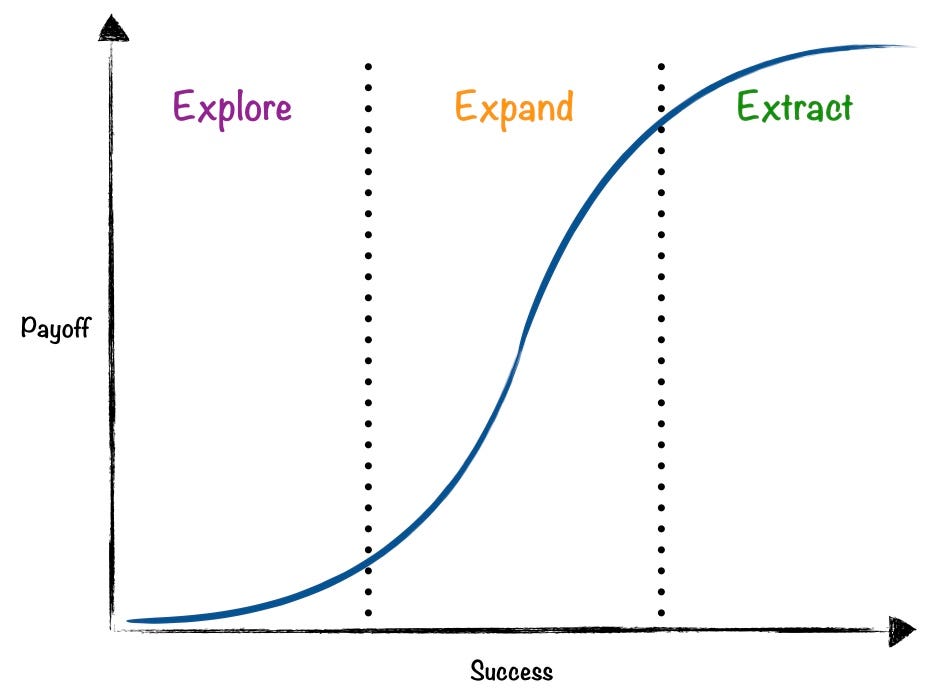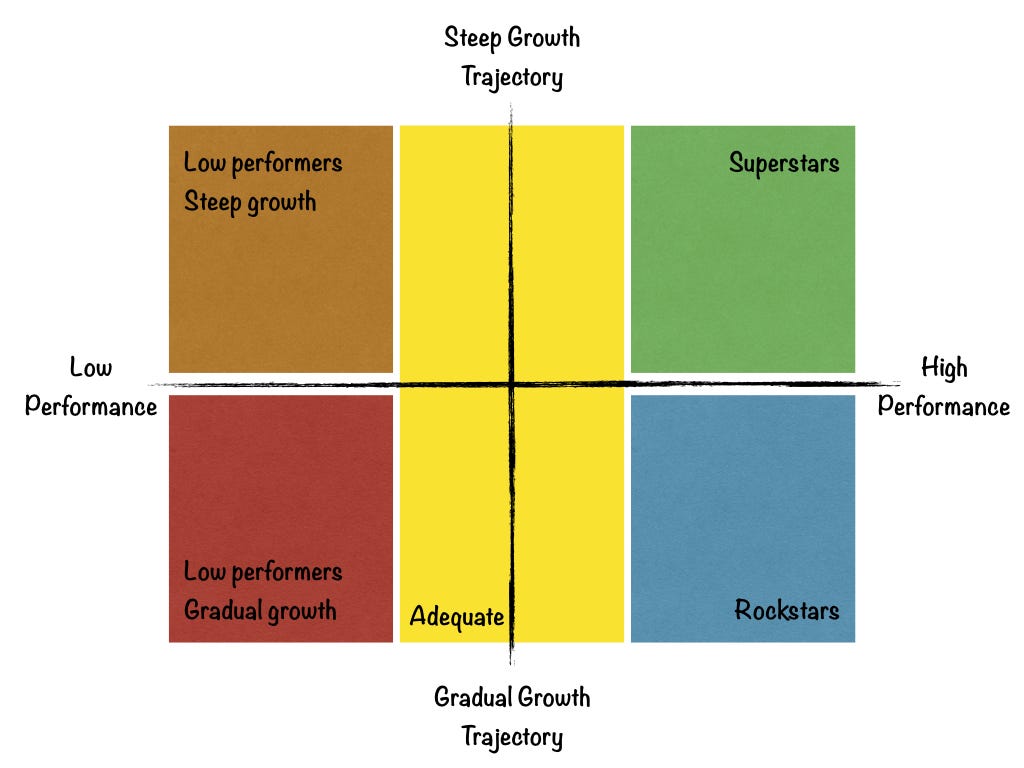
Using the AAA model to ensure everybody on your team is working on the task they fit the best
3 out of 5 people are either mismatched or mis-qualified for the tasks they are doing during the day. Did I just make up this statistic? A little bit. But it is probably not far off the mark.
Finding the right task for someone is not a simple process. A problem should not be too easy or hard. It has to be interesting to the individual. There has to be meaning. The team needs to work well together. As we can see there are lots of things to consider when matching someone to a task. But why is this important?

Solving a problem which is a good fit for someone’s ability and interest ensures regular progress. Consistent progress is directly correlated to one’s happiness. Progress and happiness then lead to high productivity, both for the individual and the team.
When someone is consistently doing work which is not well matched, the consequences are pretty obvious. They will either be completely bored and disengaged — which hurts everyone’s productivity. Or they will end up leaving the company. Both outcomes cost the team a lot of time and, potentially, money.
Unfortunately there is no simple formula to identify if someone is a good fit for a problem. Our standard approaches — gut feel or time spent in the industry — are really bad ways. Let me propose a better way!
Ability, Affinity and Ambition (AAA)
The key to knowing which task someone is suited for is making sure you understand the person’s current situation and future plan. It can be condensed into the three following questions:
- Ability: What is a person capable of doing right now?
- Affinity: What kind of work do they like doing?
- Ambition: What do they want to do in the future?
Answering those questions will help identify which team, project and task a person should be allocated to. Let us have a look at one concept / model for each of those questions.
Implementers, Solvers and Finders
Randall Koutnik gave a great talk at the lead dev conference presenting an alternative to the traditional career levels of intern, junior, senior, etc. In his words:
Do you find that most of your time is simply closing tickets, and your team rarely considers your input? Your title is Solution Implementer.
Are you given general problems and left to your own devices on how they’re fixed? […] You’re working as a Problem Solver.
Are you given near-total autonomy in choosing what you work on? […] You’re a Problem Finder.
Depending on what someone is capable of doing — based on experience and skill—they can be categorised into one of these three levels. Therefore, we will refer to this as the framework to assess one’s Ability.
3X — Explore, Expand and Extract
One of my colleagues recently shared a great concept from Kent Beck called 3X. It covers different stages of product development and the corresponding approaches needed to be successful. Three phases make up this framework:

Explore. The team is searching for a viable product, mainly through experimentation.
Expand. Scaling the product through a phase of quick growth by eliminating bottlenecks quickly.
Extract. Growth is slowing and the product is valuable. It is all about maximising profit.
Which phase a person is best suited for depends largely on choice — what someone enjoys doing. We will use this model to assess Affinity.
Growth Trajectory
The last piece of the puzzle is about personal growth. Kim Scott has a great way to approach career development by talking about one’s growth trajectory:
When you look at your team this way, you identify five different modes that people can be in. They can be in superstar mode. They can be in rock star mode. Or on various paths to reaching or recessing from those modes.

Superstar. The main focus is driving growth. They need new challenges and responsibilities to strive.
Rockstar. Individuals in this category just want to continue doing great work, without getting promoted.
Adequate performers. The goal is to grow them enough to become either superstars or rockstars.
Low performers, steep growth. This is often due to a role / task mismatch.
Low performers, gradual growth. In short, those people are not doing well and are not interested in growing. It might be time to let them go.
While this framework is both looking at performance and growth, it is centred around where team members want to be. We will use it as our measuring stick for Ambition.
AAA Team Assessment
As mentioned before, the key to matching someone to the right task, project or team is to understand where they are and where they want to be. Using the concepts and models from the last section, we are now able to assess everybody on the three dimensions of Ability, Affinity and Ambition (AAA). The following diagram shows an example of how such an assessment would look like:

Ability and Affinity: Finding the best match right now
Vertically and horizontally we can see the dimensions for Ability and Affinity. Each person will belong to one of nine combinations. This knowledge is extremely useful when a person needs to be assigned to a new task — for example a new hire starting with the company which needs to be placed in a team.
A team which is tasked with a very early and open exploration into a new business opportunity needs to be heavy on exploring finders, supported by a few solvers and implementers.
On the other hand, a team handling mostly BAU (business as usual) can be light with exploring finders, but attracts those who like to expand and extract.
Every team will have their unique needs and each person can be assigned to the currently best suited group. Most of the time projects and teams need people from multiple combinations of Ability and Affinity. It is therefore crucial to ensure you have a variety of skills and preferences across the department and company. If everybody is an exploring problem finder, who will do all the implementation work? None of the combinations is more important than others. All of them are necessary to build great teams.
Ambition: Get people to where they want to be
The second part of the AAA assessment is keeping track of the Ambition. We can see superstars (green), rockstars (blue), adequate performers (yellow) and low performers (red). Each person is either growing, stable or getting worse — indicated by the direction and length of the arrow.
In addition to Ability and Affinity which assists with the current assignment, the growth trajectory is crucial information to help with the short- and long-term development of people.
To identify those who might be currently mismatched, a low or adequate performance might be combined with a decent growth. The result will be disengagement and the person will not work at peak productivity. Moving the person to a more suitable task or project as quickly as possible will in most cases increase performance. If the switch does not happen within a reasonable time, the disengaged employee might look for other opportunities.
Looking more longer term, it is important to give those on a steep growth trajectory new opportunities and responsibilities — especially your superstars. If this does not happen the result can be the same as with those who are mismatched: they might end leaving the company. Rockstars on the other hand, do not want or need new responsibilities or a promotion. It would have the opposite effect as for superstars.
Summary
A lot of happiness and productivity is thrown away because some — if not most — of your employees are mismatched to the tasks and projects they work on.
By assessing our team on Ability, Affinity and Ambition (AAA) we can provide a better way than gut feel or playing favourites. It allows us to find the best team for a person right now, as well as consider the career development for each individual in the short- and long-term.
